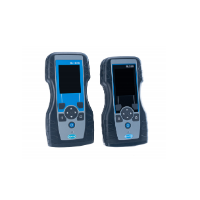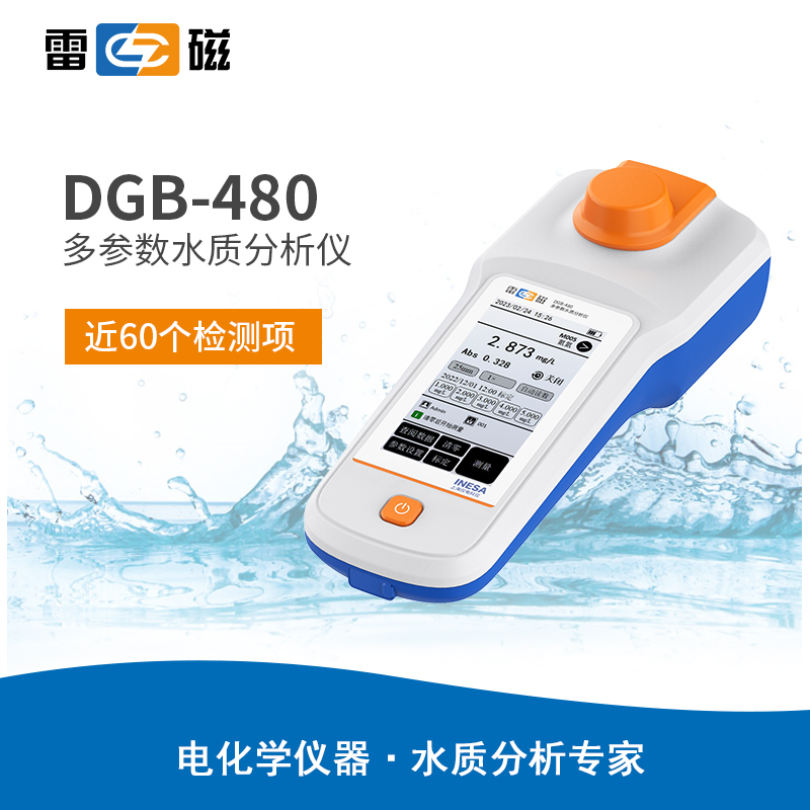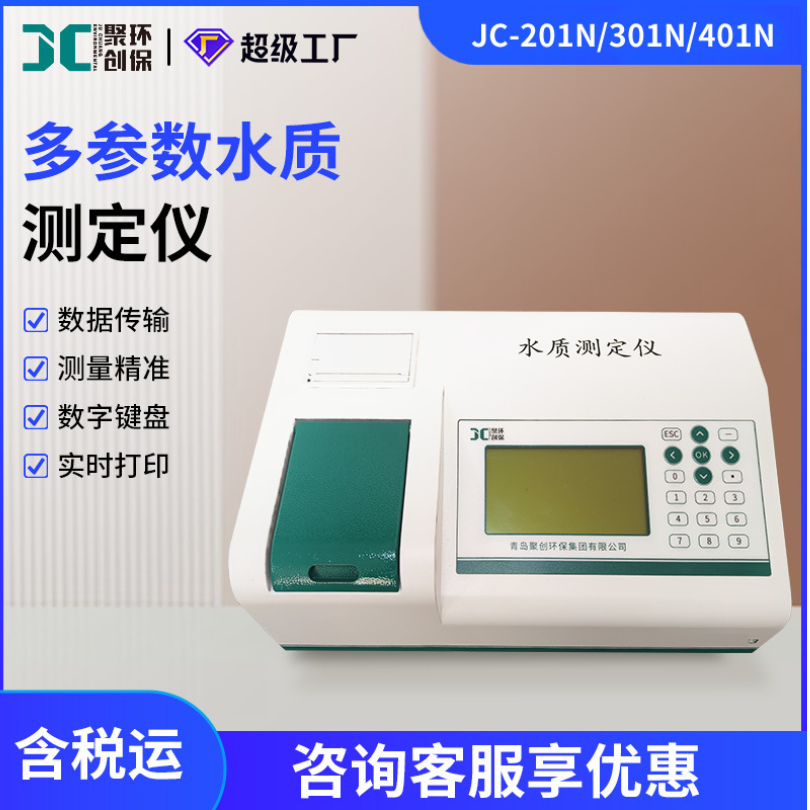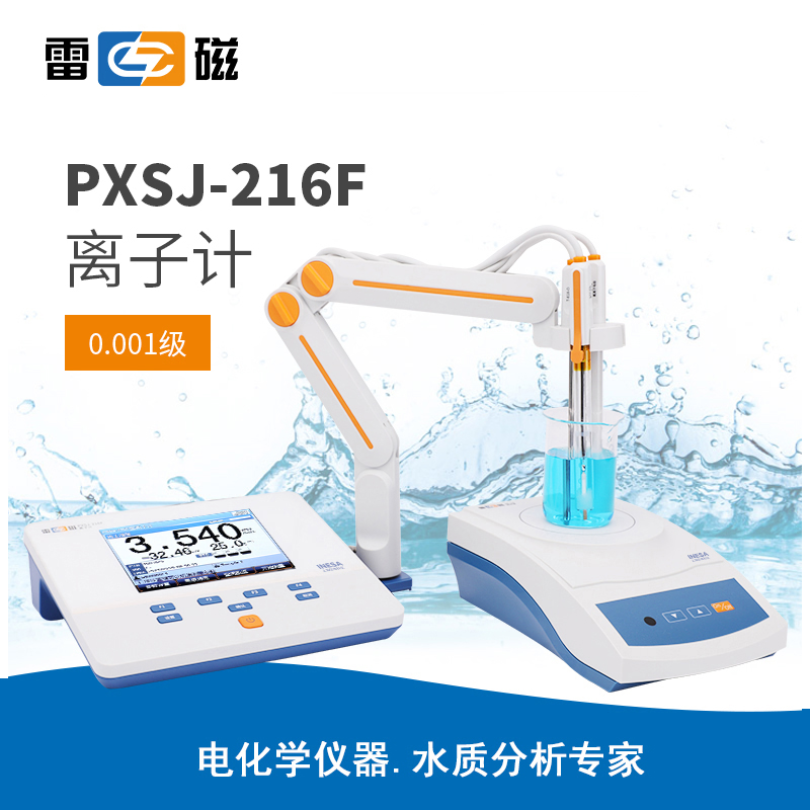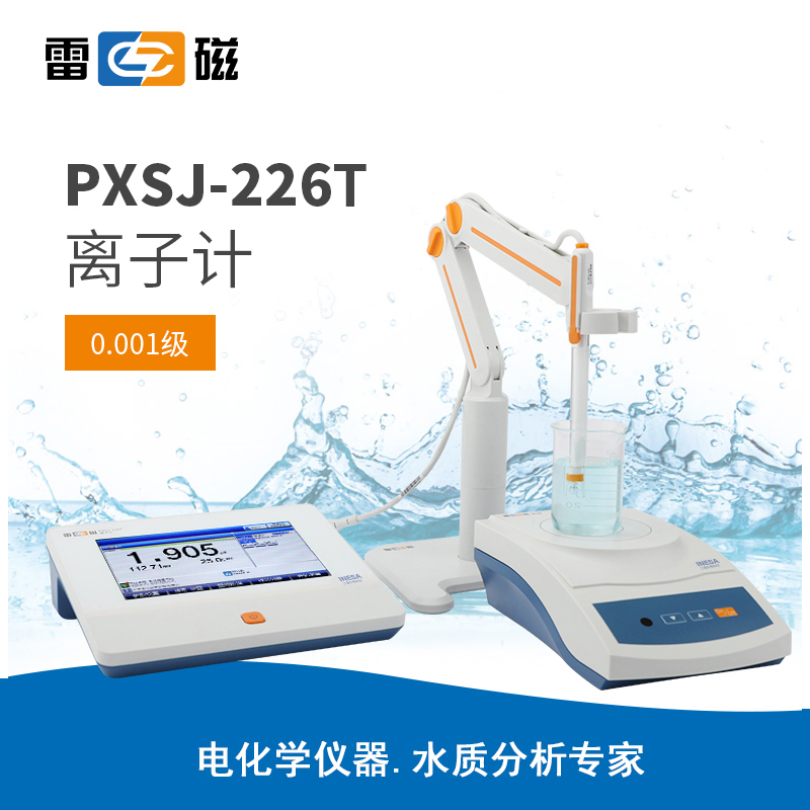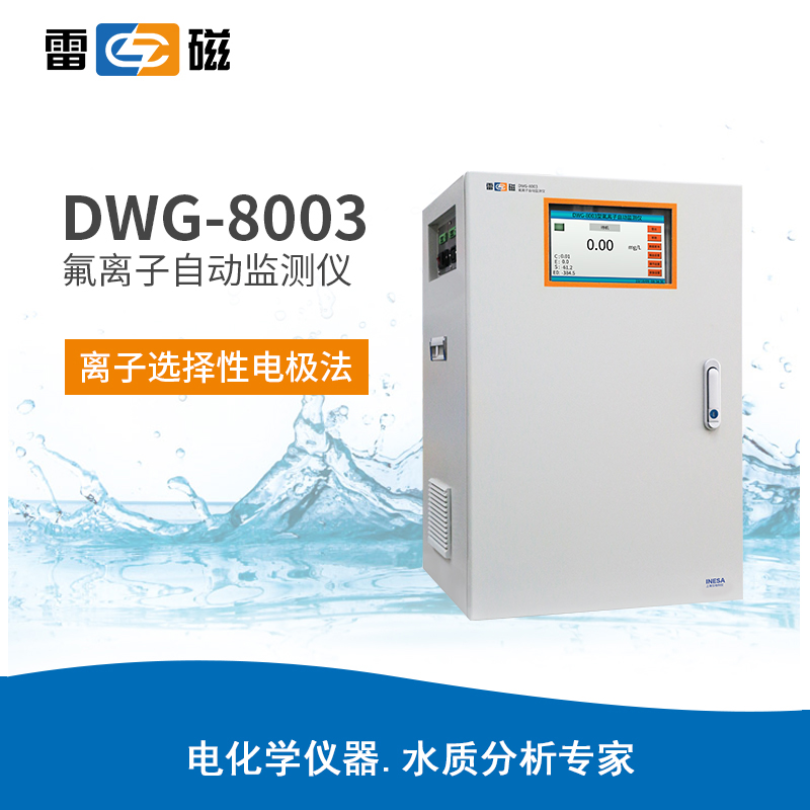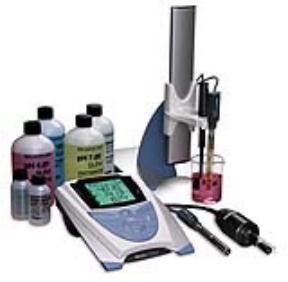
本文章详细介绍了薯片中氯离子的测定,包括校准液、水样的准备,校准和测量过程,以及电极和仪表的维护等内容。
方案详情

Chloride inSnack Chips/Crisps Star SeriesMethod Note M-1417-E 03/05 RevB Chloride inSnack Chips/Crisps Calibration and Analysis ·Chloride (assodium chloride) Introduction 1.Allow all the standards and the samples to attain room temperature for precise measurements since themeasurement is temperature sensitive. Chloride, reported as % salt, is measured to perform a quality control step and to satisfy labelingrequirements. Results compare favorably with the Mohr method and atomic absorption. 2.Calibrate the meter using the 0.5 % followed by the 5 % standard, stirring the standards at a gentleand uniform rate. ·Snack Chips/Crisps·Orion ionplus@Sure-Flow@solid statecombinationChloride Electrode Recommended Equipment Cat.No. 3. Place the electrode, ATC probe and stirrer into the beaker with the 0.5 % standard such that theelectrode tip is fully immersed in the solution. The stirrer should be positioned slightly below the tipof the electrode. Press the STIRRER key on the meter to turn the stirrer on. Press the CALIBRATEkey. Chloride in Snack Chips/Crisps Application Package (includes all items with a catalog number) 1010148 1. 4 Star benchtop pH/ISE meter 1115000 4.Wait for a stable reading (1-2 minutes). Enter the standard value of“0.5” using the UP and DOWNarrow keys and the DECIMAL/DIGIT key. 2. ionplus chloride electrode 9617BNWP 3. Stainless Steel ATC probe 927007MD 5. Press the CALIBRATE key to accept the 0.5% standard and press the STIRRER key to turn thestirrer off. 4. Orion benchtop stirrer (or magnetic stir plate and bar) 096019 6.Rinse electrode, ATC probe and stirrer thoroughly with deionized water. Gently remove excesssolution from the outer sleeve of the electrode by dabbing with a clean paper tissue. Do not wipe orrub the sensing element of the electrode. 5. Beakers (150 mL) 6. Graduated cylinder (50 mL) 7. Pipettes (1 mL, and 10 mL) 7.Place the probes and stirrer into the beaker with the 5 % standard such that the electrode tip is fullyimmersed in the solution. The stirrer should be positioned slightly below the tip of the electrode.Press the STIRRER key on the meter to turn the stirrer on. Volumetric flasks (50 mL, 500 mL, and 1000 mL) ). Balance 8.Wait for a stable reading (1-2 minutes). Enter the standard value of“5”using the UP and DOWNarrow keys and the DECIMAL/DIGIT key. Required Solutions Cat.No. 9P.ress the MEASURE key to accept the 5 % standard and to move to the measure mode of the meter.Press the STIRRER key to turn the stirrer off. 1.5% sodium chloride standard as NaCl 941104 2. ISA (Ionic Strength Adjustor) for chloride electrode 9400011 10. Rinse electrode, ATC probe and stirrer thoroughly with deionized water. Gently remove excesssolution from the outer sleeve of the electrode by dabbing with a clean paper tissue. Do not wipe orrub the sensing element of the electrode. 3. ReFference Filling Solution, Optimum Results"B 900062 4. Concentrate nitric acid 5. Deionized water 11. Place the probes and stirrer in a prepared sample with the electrode tip fully immersed in the solution.Press the MEASURE key on the meter; the stirrer will turn on. The ISE:% icon will flash as themeasurement is being made. The ISE: % icon will become solid and the display value will freeze whena stable reading is achieved. This value is logged and printed automatically and the stirrer turns offautomatically. Calibration Standard Preparation 1. To prepare a 0.5 % sodium chloride standard, pipette 10 mL of the 5% sodium chloride standardinto a 100 mL volumetric flask. Dilute to the mark with the deionized water. Mix well. 12. Repeat steps 10 and 11 for additional samples. Upon completion of samples, rinse electrode withdeionized water and store the electrode according to instructions in the Electrode Storage section ofthis method note. 2.E1xtracting Solution (nitric acid): add approximately 800 mL distilled water into a 1000 mL volumetric flask. Pipette 10 mL of the concentrate nitric acid (HNO,) to the same flask, swirl to mix and dilute to the mark with the deionized water. To prepare 0.5% sodium chloride standard with extracting solution and ISA, pipette 1 mL of the 0.5% sodium chloride standard,and1 mL of the ISA solution into a 50 mL volumetric flask. Dilute to the mark with extracting solution. Add 50 mL of the prepared standard to a 150 mL beaker use a graduated cylinder. 5. To prepare 5% sodium chloride standard with extracting solution and ISA, pipette 1 mL ofthe 5% sodium chloride standard, and 1 mL of the ISA solution into a 50 mL volumetric flask. Dilute to the mark with extracting solution. Add 50 mL of the prepared standard to a 150 mL beaker use a graduated cylinder. ( Environmental Instruments Water Analysis Instruments ) ( 1 66 Cummings C enterBeverly, MA 01915 USA M - 1 4 17-E 03/05 R evE248109-001 ) Toll Free: 1-800-225-1480Tel:1-978-232-6000Dom. Fax:1-978-232-6015Intl Fax: 978-232-6031www.thermo.com/waterO 2005 Thermo Electron CorporationDn. RegisteredIS O9001:2000 AAlll rights reserved Chloride inSnack Chips/Crisps Sample Preparation Crush the sample into crumbs such that it can be used easily. 12Weigh out 10.00 g (+0.01 g) of the sample into a 500 mL volumetric flask. Add 10 mL of the ISA solutionand 350 mL of the extracting solution into the same flask. 3. Shake the sample for 10 minutes. Cool and dilute to the mark with extracting solution. 4.Measured 50 mL of the prepared sample into a 150 mL beaker using a graduated cylinder. Results Five aliquots of prepared chips were measured for sodium chloride. The data in the table below is representativeof the results expected for sodium chloride in chips. Prepared chips % NaCl Sample #1: 2.13 Sample #2: 2.20 Sample #3: 2.23Sample #4: 2.22 Sample #5: 2.22 Mean: 2.20 Standard Deviation: 0.04 %CV 1.85 Electrode Storage For brief storage periods between sample measurements, store the electrode in the 0.05 %(-0.01M)sodium chloride standard. The fill solution in the electrode should not be allowed to evaporate, which causescrystallization. For longer storage periods, drain the electrode. Flush the inside with deionized water and storedry with a protective cap to protect the sensing element. Ifelectrode response is slow, polish the sensing elementby cutting off 1 inch of the polishing strip and polish the electrode-sensing element with a circular motion forabout 30 seconds. Rinse the electrode with deionized water and soak in the 0.05%(-0.01M) standard forfive minutes. Equipment Setup Electrode Setup-ionplus electrode 1.Remove the rubber cap covering the electrode tip. Fill outer chamber with Optimum Results B filling solution. Lift the spout to a vertical position. 4. Insert the spout into the filling hole in the outer sleeve and add a small amount of filling solution to thechamber. Tip the electrode to moisten the O-ring at the top and return electrode to a vertical position. 5. Holding the electrode by the barrel with one hand, use the thumb to push down on the electrode cap,allowing a few drops of filling solution to drain wetting the inner cone. 6 Release sleeve. If sleeve does not return to its original position immediately, check to see if the 0-ring ismoist enough and repeat steps 4-6 until the sleeve has returned to original position. Add filling solution upto the filling hole. For initial meter setup, follow the steps in the Quick Reference Guide, which is attached to the meter itself.The Quick Start Guide included with each meter also contains a layout of the meter keypad for reference. Thewords in this method represented in all capital letters, such as POWER,indicate a key on the meter, and wordsin quotations such as “Unit"indicate information on the meter display. 1. Connect the electrode to the meter 2. Connect the ATC probe to the meter. 3.Connect the stirrer to the meter. 4.Press the POWER key on the meter to turn the meter on. 5N.ote that the arrow on the left of the screen indicates the active line. If the top line is not active, press theLINE SELECTION key to change the selected line to the top line. Then press the UP or DOWN arrowkeys to change the measurement mode of the top line to ISE. 6.Press the SETUP key to enter ISE setup. Press the LINE SELECTION key to select the bottom line.Press the UP or DOWN arrow keys to select“3”for “rES”which is an abbreviation for resolution ornumber of significant digits. Press the LINE SELECTION key to accept setting. 17.Press the LINE SELECTION key to select the middle line, and press the DOWN arrow key to select “nLln"which is an abbreviation for non-linear blank correction. 8.Press the LINE SELECTION key to select the bottom line. Press the UP or DOWN arrow keys to select“offfor "nL In". Press the LINE SELECTION key to accept setting. 9.Press the LINE SELECTION key to select middle line, and press the DOWN arrow key to select “rAng”which is an abbreviation for measurement range. 10. Press the LINE SELECTION key to select the bottom line. Press the UP or DOWN arrow keys to select“HigH"for “rAng". Press the LINE SELECTION key to accept setting. 11. Press the LINE SELECTION key to select the middle line, and press the DOWN arrow key to select“Unit". 12. Press the LINE SELECTION key to select the bottom line. Press the UP or DOWN arrow keys to select“PEr”(%) for “Unit". Press the LINE SELECTION key to accept setting. 13. Press the MEASURE key to return to the measurement mode. If all steps were followed correctly themeter display will show three digits in the top line and"ISE: PEr"to the right of the top line. The meterand electrode are now ready for calibration. Note: The Orion Benchtop Stirrer must be turned on in General Instrument Setup www.thermo.com of of of of
确定

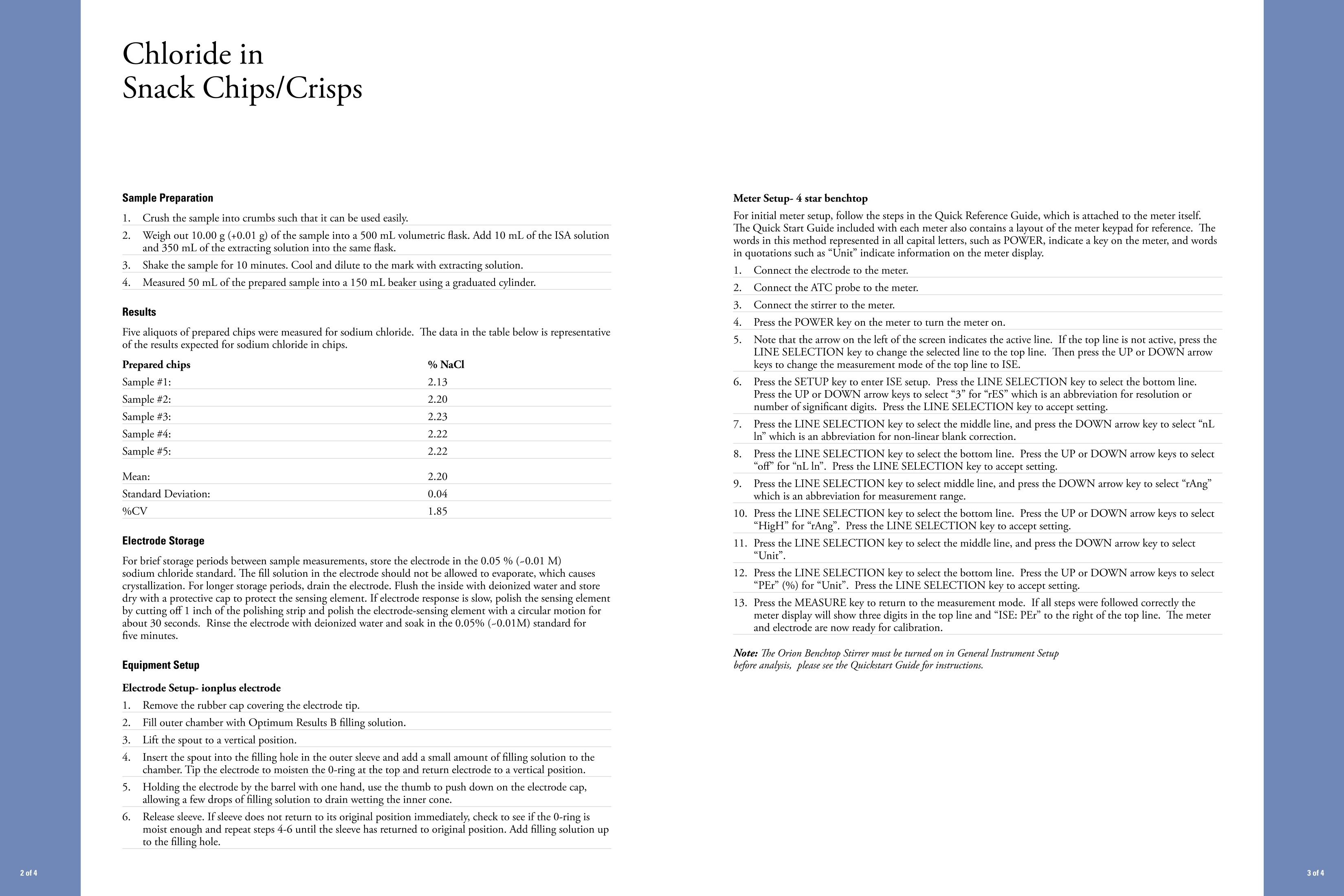
还剩1页未读,是否继续阅读?
赛默飞中国实验室产品事业部为您提供《薯片中氯离子检测方案 》,该方案主要用于薯类和膨化食品中理化分析检测,参考标准--,《薯片中氯离子检测方案 》用到的仪器有台式pH/ORP/ISE/溶解氧/电导率测量仪、Orion 4-Star台式(便携式)pH/离子浓度测量仪
推荐专场
相关方案
更多
该厂商其他方案
更多











